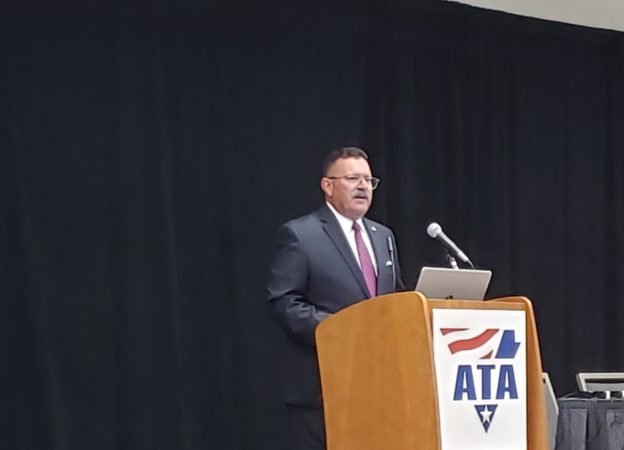FMCSA says infrastructure upgrades will stoke already hot U.S. economy
SAN DIEGO, Calif. – The American Trucking Associations’ (ATA) annual Management Conference (MCE) and Exhibition opened on a positive note yesterday, painting an economic picture that has benefited the industry for years.
The U.S. economy has been growing at a frantic pace since 2018, and with historically low unemployment numbers at 3.7%, the lowest in 50 years, Federal Motor Carrier Safety Administration (FMCSA) administrator Ray Martinez said he would like to see the trend continue.
One of the ways Martinez said government can help maintain economic growth is by improving roads and bridges across the U.S.
“We need a major infusion of infrastructure rebuilds in this country,” urged Martinez, saying the effort would be beneficial to both the trucking industry and all motorists.
Martinez said he is looking for a major U.S. bill that would fund nationwide infrastructure improvements, adding that if the transportation sector, trucking specifically, is not safe and efficient, all other sectors suffer.

During his opening speech in San Diego, Calif., during MCE, Martinez highlighted some of the key initiatives the FMCSA has been advocating for to help the trucking industry.
One of those efforts is the proposed rule changes around HOS. First announced in August, Martinez underscored five changes to the rule, including changing driver’s 30-minute mandatory rest within eight consecutive hours of driving to an on-duty break; splitting sleeper berth time into seven/three- or eight/two-hour windows; allowing drivers to extend their driving day by two hours during adverse conditions; extending the shorthaul exemption by two hours or 50 miles; and allowing an off-duty break of 30 to 180 minutes that pauses the driver’s 14-hour work window, as long as the shift is followed by 10 consecutive hours off-duty.
Martinez said the implementation of electronic logging devices (ELDs) has shed light on HOS issues, and the overall goal is to improve safety while allowing flexibility to satisfy a diverse industry.
“These are well thought out and you may not agree with all of them, but this is a very diverse industry,” Martinez said. “This is still only a proposal, and it’s not law.”
Continuing to tout a driver shortage in the industry, Martinez said the FMCSA’s Under 21 Military CDL Pilot Program has been successful in brining former military into trucking.
“We think this is smart and profitable,” Martinez said, urging those in the room to take advantage of the skills veterans bring to the table.
The FMCSA is also looking at an under-21 non-military program.
Other projects the FMCSA has on its plate include the Crash Preventability Demonstration Pilot Program, which launched in 2017 and ended its first phase July 31 this year. The program investigates collisions that occurred after June 1, 2017 to determine preventability. FMCSA will then display those found to not be preventable, of which, Martinez said 94% were found to be just that.
A new crash preventability program started Aug. 1.
Martinez said the FMCSA is also encouraging carriers to adopt new technologies that align with the goals to support safety and innovation. Working with the ATA, the FMCSA aims to educate fleets and owner-operators that are not yet aware of these benefits.
“If we’re doing this outreach, we want to see that people are adopting these new technologies,” said Martinez. “This is a concrete example of what I call active collaboration.”
In addition to highlighting the upcoming Drug and Alcohol Clearinghouse – an online database to ensure drivers are drug and alcohol free – Martinez said another example of active collaboration is the Our Roads, Our Safety initiative.
Our Roads, Our Safety, which the ATA was a founding member, is a video series that provides voices from the industry with the goal of raising awareness and educating motorists on how to share the road with commercial vehicles.
The videos have been shown over 360 million times across all mediums in the U.S. to help get the message out to the public.
Have your say
This is a moderated forum. Comments will no longer be published unless they are accompanied by a first and last name and a verifiable email address. (Today's Trucking will not publish or share the email address.) Profane language and content deemed to be libelous, racist, or threatening in nature will not be published under any circumstances.